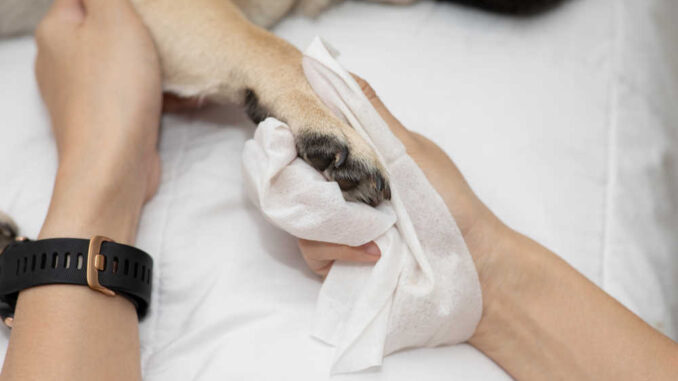
This article was updated on January 10th, 2024
Ahh dog feet, giant Great Dane Marmaduke paws, tiny terrier tootsies, the puffy, fluffy white feet of a Bichon Frisé. As dog lovers, we love them all. As veterinarians, we see lots of dogs with lumps and bumps on their feet. These lumps range from hardly noticeable and non-irritating to prominent, inflamed, itchy or painful lumps oozing sticky fluid. In this article, we will review the most common types of cysts found on dog’s paws and pawpads.
If you are not sure if your dog’s bump is indeed a cyst, check out our visual guide of paw bumps, lumps and sores.
Types of cysts often found on a dog’s paw
There are a few types of cysts you might find on your dog’s paw. Interdigital follicular cysts are one of the cysts found on a dog’s paw and probably the most problematic.
1. Interdigital follicular cysts
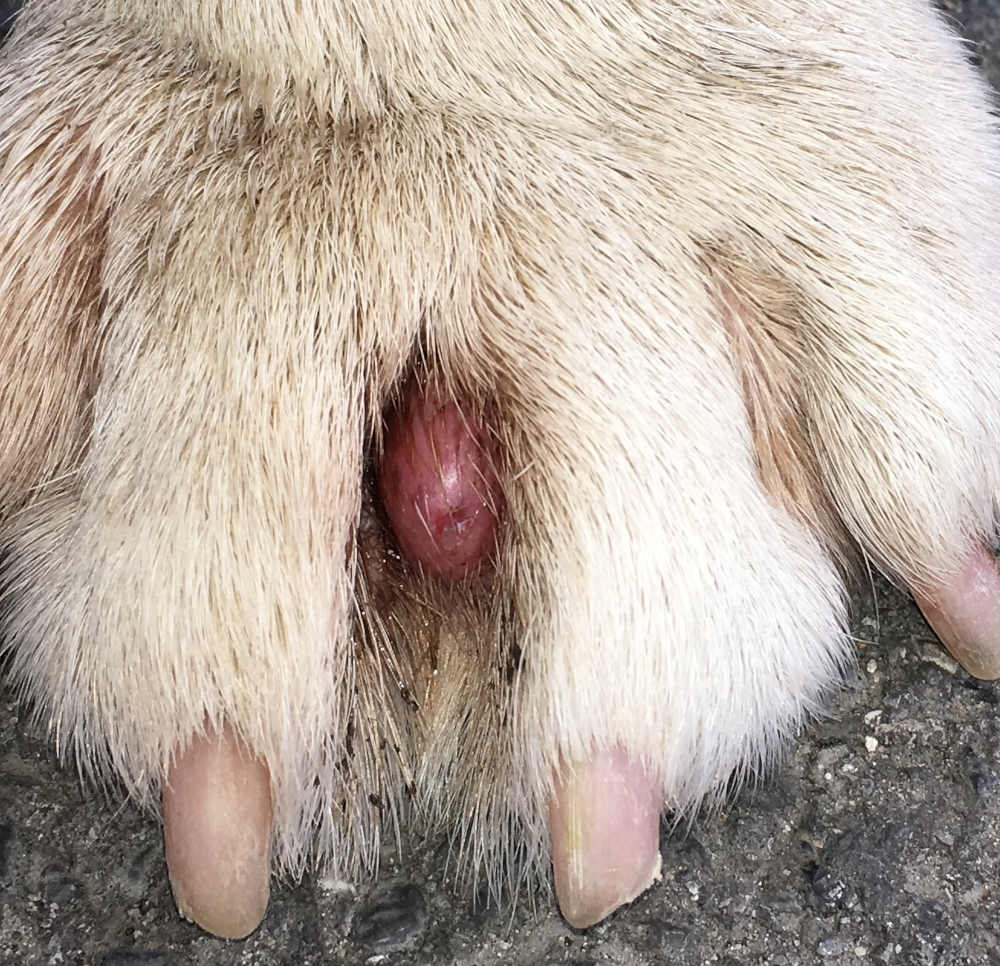
Interdigital follicular cysts appear as a small swelling or cyst found where the toes meet on the top of the foot or in between the toes (digits). This occurs mainly on the front paws.
In minor cases the surrounding skin may appear normal. In more extreme cases, the skin around the cysts may be red and angry. There may be some blood or pus present. The toe webbing may be thickened and inflamed. These interdigital cysts are symptomatic of a deeper, more serious problem. A deep bacterial infection or chronic inflammation is most likely present in your dog’s paw.
Learn more about interdigital cysts on dog paws (pictures, treatment, home remedies)
2. Follicular cysts
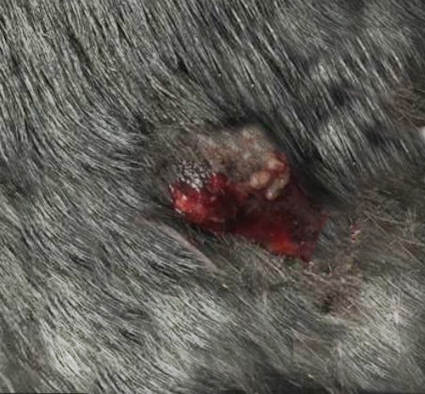
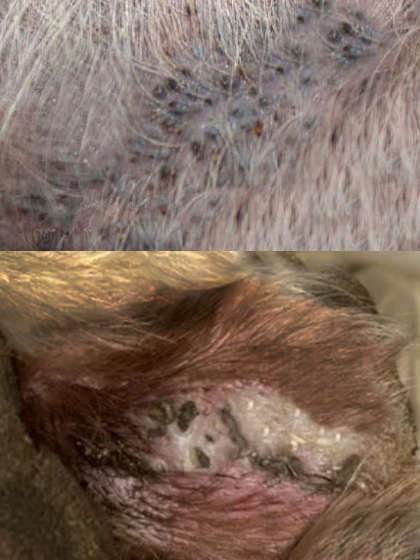
A follicular cyst is associated with the base of a hair follicle. When the follicle becomes inflamed and dilated the hollow space the follicle sits in collects body oil, dirt, sweat, excess cellular debris and sometimes keratin (a protein that helps form skin, hair and nails). It eventually forms a cyst.
A follicular cyst is somewhat round and nodular in appearance. It may be tinged blue or it may be darker, like a black head. It can range in size from 1/4 inch to approximately 2 inches.
A follicular cyst is found on or just under the skin. Sometimes follicular cysts rupture and ooze. The contents of a follicular cyst may be black or white or yellow. It may be fluid or have a thick, pasty consistency. It often has an unpleasant smell.
Treating a follicular cyst: Follicular cysts are often seen secondarily to a preexisting skin condition. If the cyst or cysts are not extensive and not bothering your dog your veterinarian may prescribe antibiotics, anti-inflammatory medications and medicated shampoos. If the cysts resolve, the next step is to get on top of the underlying dermatitis that led to the cyst development.
If medical treatment is not working, the cyst has ruptured or is bothersome to your pooch or reoccurs after initial treatment, surgical removal is indicated. There is no “home remedy” for follicular cysts. Medicated shampoos may be helpful, but veterinary care is recommended for a true resolution. Learn more about follicular cysts in dogs.
+++
If you are not sure if your dog’s bump is indeed a cyst, check out our visual guide of paw bumps, lumps and sores.
+++
3. Sebaceous cyst
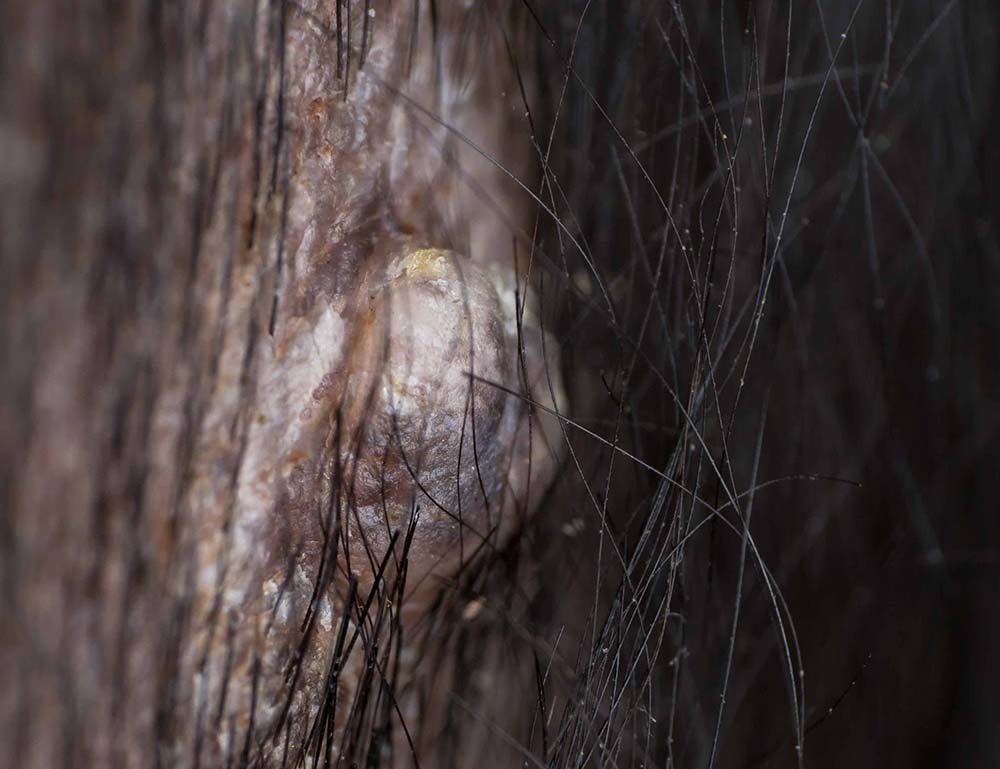
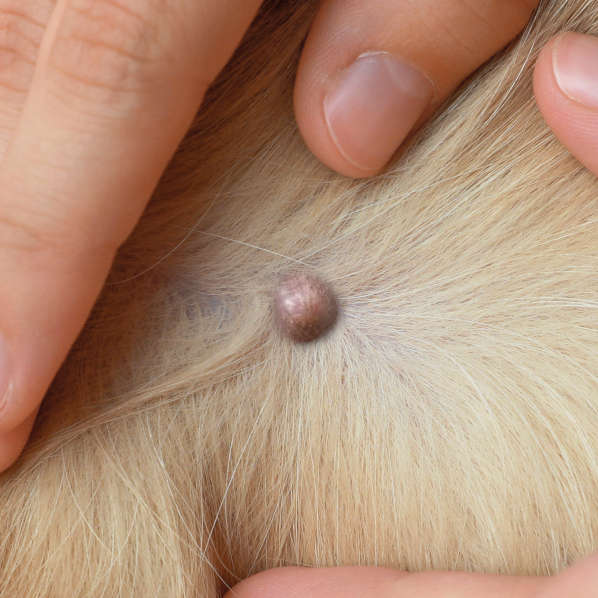
A sebaceous cyst forms in and around the sebaceous gland when there is an excess buildup of sebum, the oil the gland produces to help keep skin moist and healthy. When the opening from the gland is blocked due to skin trauma or inflammation the sebum accumulates causing a cyst to form. Some sebaceous cysts contain only sebum. Most also contain other waste such as excess keratin or dead cells.
A sebaceous cyst is usually small (approximately 1/4 to 1/2 inch), and somewhat round. It is attached to the outer surface of the skin. Its color usually matches the color of the surrounding skin, but it may also be a pink tinged white.
Treating a sebaceous cyst: Once diagnosed by your veterinarian it may be the best option to leave a sebaceous cyst alone. If a sebaceous cyst is not causing any pain or discomfort and is not infected, you can choose to leave it alone. If it becomes a problem, becoming red and inflamed or ulcerating, surgical excision is often the recommended treatment. Sebaceous cysts may remain small and harmless for your dog’s entire life. Choosing to monitor and not treat these cysts is perfectly reasonable.
Learn more about Sebaceous Cysts.
4. Comedones
Comedones or blackheads are clogged pores. They are very similar to follicular cysts but have a wide opening on the surface of the skin that allows them to be manually squeezed and the thick contents expelled. Comedones appear as small, black slightly raised bumps.
Treating comedones: Because comedones can be emptied by squeezing them, it is tempting to treat them on your own. This is not recommended. You may think you are dealing with a blackhead when it is really something else. Also, squeezing may cause inflammation or introduce bacteria causing a deep infection.
Once your veterinarian has diagnosed comedones, they may recommend some at home treatments for you. Medicated shampoos containing benzoyl peroxide are indicated. Make sure you use one specific to dogs. If infected, your veterinarian may prescribe antibiotics.
Will a cyst on a dog’s paw go away on its own?
Most dog’s cysts will not go away on their own. If a dog has healthy skin and a cyst formed due to some kind of traumatic injury to the area, it may resolve when the injury clears up. If a cyst is due to underlying disease, curing the underlying disease may also clear up the cyst.
Does a cyst need to be treated or can it be left alone?
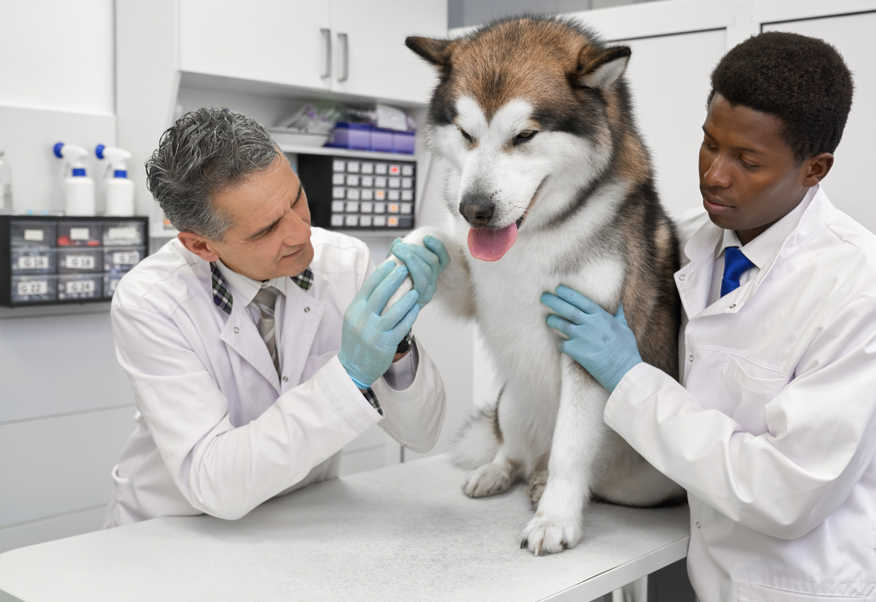
Any cyst cleared as not cancerous by your veterinarian and not bothering your dog can be left untreated for a time. If the cyst is small and is not bothering the dog, it may be left alone as long as there are no complications. Cysts need to be monitored for any signs of worsening or infection, so as not to be neglectful to your best friend’s health: rupturing, enlarging, or infection are all complications or changes that warrant a trip to your veterinarian. This will also help ensure that the mass has not become cancerous.
What about home remedies?
While some home remedies may be beneficial, they are generally not recommended. This is because it may not be safe to use an “unknown” treatment. If you really want to try something recommended to you by someone you trust, please run it by your veterinarian first to make sure it will not harm your pooch.
How do I know when to call my vet
If a cyst on your dog’s paw is not red or irritated, oozing fluid or giving off a foul odor it is ok to wait a bit until calling your veterinarian. Keep in mind what you think is a benign cyst may really be malignant, so don’t wait too long. Make sure you point the cyst out to your veterinarian on your dog’s next wellness exam.
Also, is your dog bothered by the cyst? Is he or she still eating and drinking and playful? It is important to keep an eye on your dog’s overall health in relation to the cyst and the time that the cyst first appeared. Dogs showing other signs of discomfort or illness should see a veterinarian as soon as possible.
Veterinarian diagnosis may involve a visual exam & fine needle aspirate
Your veterinarian will examine the cyst visually for shape, color and location. They will palpate it for texture, firmness and how it is attached to or under the skin. The skin around the cyst will be evaluated as well. The price for a physical exam can range from $35 to $250 depending on the location, with the average being $60-$80.
Your veterinarian may be content to make a diagnosis from their exam findings and your dog’s history.
If not comfortable diagnosing the cyst based on physical exam, they may take a fine needle aspirate. A small needle is inserted into the cyst and the insides drawn out. Microscopic examination of the contents will often make the definitive diagnoses. The price of a Fine Needle Aspirate and cytology ranges from $20.00 to $100.00.
Some aspirate samples are not definitive and a biopsy may be necessary. This is where a piece of the cyst wall is taken for microscopic examination. Your dog will need to be sedated for this procedure. Because of the sedation necessary a biopsy is a bit pricier, ranging from $400.00 to $800.00. It may make more sense to just have the cyst removed.
Be sure and let your veterinarian know how much you can afford to spend. They can structure their treatment approach to fit both your wallet and your dog’s needs.
What Is a Cyst?
A cyst is a closed off tissue pocket filled with fluid or semi solid material. Cysts of the skin typically form when ducts associated with sweat or sebaceous glands are blocked. Most cysts are benign but may still be problematic. You learn more about dog cysts in our article: 6 Types of Cysts in Dogs (With Pictures). In this article, we will review specifically cysts found on dog paws. Let’s have a look!
Related posts about paw issues:
 Dog Paw Allergy Issues: 6 Tips to Help Your Dog [With Pictures] - One of my pet parents brought her dog into the clinic because he was furiously licking and chewing on his… [...]
Dog Paw Allergy Issues: 6 Tips to Help Your Dog [With Pictures] - One of my pet parents brought her dog into the clinic because he was furiously licking and chewing on his… [...] White Bumps on a Dog’s Paw: Most Likely Reasons - If you’ve noticed a new white bump or lump on your dog’s paw you’re probably wondering what’s causing it. White… [...]
White Bumps on a Dog’s Paw: Most Likely Reasons - If you’ve noticed a new white bump or lump on your dog’s paw you’re probably wondering what’s causing it. White… [...] Paw Yeast Infections in Dogs: What They Look Like & What To Do - When most people think of yeast, the first thing to come to mind would probably be a freshly baked loaf… [...]
Paw Yeast Infections in Dogs: What They Look Like & What To Do - When most people think of yeast, the first thing to come to mind would probably be a freshly baked loaf… [...]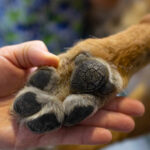 Paw Problems: 8 Common Lumps on Dog Paws [16 Pictures] - Seeing skin issues is a nearly everyday thing at our veterinary clinic. This article will help you identify lumps, bumps,… [...]
Paw Problems: 8 Common Lumps on Dog Paws [16 Pictures] - Seeing skin issues is a nearly everyday thing at our veterinary clinic. This article will help you identify lumps, bumps,… [...]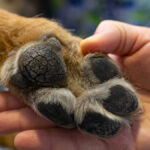 Dog with Cracked Paws? Our Veterinarian Explains What to Do - A dog’s feet often seem indestructible. After all, they’re on the go in all types of terrain, allowing your dog… [...]
Dog with Cracked Paws? Our Veterinarian Explains What to Do - A dog’s feet often seem indestructible. After all, they’re on the go in all types of terrain, allowing your dog… [...]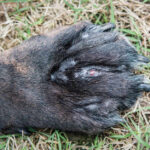 Dog with Swollen Paws [with Pictures] Our Veterinarian Explains What to Do - A dog with swollen paws or paw pads may be suffering from something as simple as a thorn in their… [...]
Dog with Swollen Paws [with Pictures] Our Veterinarian Explains What to Do - A dog with swollen paws or paw pads may be suffering from something as simple as a thorn in their… [...]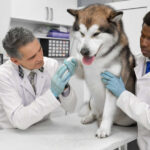 Dog Paw Infections and Issues: Pictures & Vet Advice - Dog paw infections are one of the more common issues that we treat in our veterinary hospital: dogs often excessively… [...]
Dog Paw Infections and Issues: Pictures & Vet Advice - Dog paw infections are one of the more common issues that we treat in our veterinary hospital: dogs often excessively… [...] Why Is My Dog Constantly Licking His Paws? Veterinarian Advice - You may notice your dog licking his paws on occasion. This is often just part of his everyday grooming routine;… [...]
Why Is My Dog Constantly Licking His Paws? Veterinarian Advice - You may notice your dog licking his paws on occasion. This is often just part of his everyday grooming routine;… [...]Related posts about cysts:
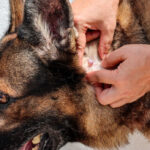 Types of Cysts Often Found on a Dog’s Neck or Head [Vet Advice] - Canine cysts of the head and neck are fairly common and most of them don’t cause serious problems. There are… [...]
Types of Cysts Often Found on a Dog’s Neck or Head [Vet Advice] - Canine cysts of the head and neck are fairly common and most of them don’t cause serious problems. There are… [...] Eyelid Cysts in Dogs: FAQ With Our Veterinarian - Eyelid cysts are very common, particularly in older dogs. Oftentimes, an owner is unaware that they’re present as they can… [...]
Eyelid Cysts in Dogs: FAQ With Our Veterinarian - Eyelid cysts are very common, particularly in older dogs. Oftentimes, an owner is unaware that they’re present as they can… [...] Burst or Ruptured Cysts on Dogs: Our Vet Shares What to Do - When a dog does come into my clinic with a ruptured cyst, the owner can be quite alarmed by the… [...]
Burst or Ruptured Cysts on Dogs: Our Vet Shares What to Do - When a dog does come into my clinic with a ruptured cyst, the owner can be quite alarmed by the… [...] Dog Hair Follicle (Follicular) Cysts: Pictures + Vet FAQ - It is extremely common for dogs to develop lumps and bumps anywhere on their body. They can range in size,… [...]
Dog Hair Follicle (Follicular) Cysts: Pictures + Vet FAQ - It is extremely common for dogs to develop lumps and bumps anywhere on their body. They can range in size,… [...] Eye Cysts in Dogs: Pictures & Vet Advice - Introduction: about eye cysts in dogs Finding an unexpected growth or mass on your dog can be distressing, but it… [...]
Eye Cysts in Dogs: Pictures & Vet Advice - Introduction: about eye cysts in dogs Finding an unexpected growth or mass on your dog can be distressing, but it… [...]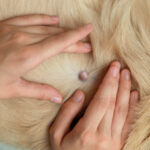 6 Types of Cysts in Dogs [With Pictures], and How to Treat - As a practicing veterinarian for over 17 years, I have treated hundreds of dogs with cysts. Cysts are a very… [...]
6 Types of Cysts in Dogs [With Pictures], and How to Treat - As a practicing veterinarian for over 17 years, I have treated hundreds of dogs with cysts. Cysts are a very… [...] Sebaceous Cysts in Dogs [Pictures & Veterinarian Advice] - Sebaceous Cysts in dogs is one health issue for which dog owners should be watchful, but thankfully, they are rarely… [...]
Sebaceous Cysts in Dogs [Pictures & Veterinarian Advice] - Sebaceous Cysts in dogs is one health issue for which dog owners should be watchful, but thankfully, they are rarely… [...]Disclaimer: This website's content is not a substitute for veterinary care. Always consult with your veterinarian for healthcare decisions. Read More.

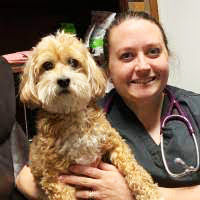

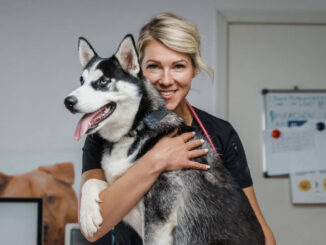
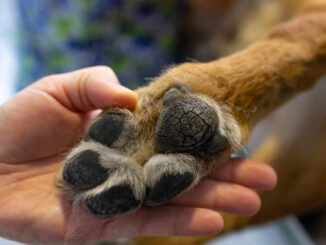
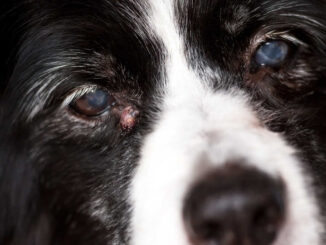
Be the first to comment